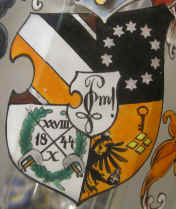 A
German Student Association Stein
A
German Student Association Stein
By John Piet
Most stein collectors will recognize this month's stein as a German
student association stein. The German student associations are similar
to, but quite different from the fraternities of the American colleges
and universities. It was a practice among the members to give gifts to
their friends in the association, and in the "golden" era of steins,
from around the mid 1880s to the start of the First World War, steins
became the common gift of choice. Most student association steins will
have the association's coat of arms, Wappen,
an inscription dedicating
the gift and sometimes the name and motto of the association.
Some of the challenging aspects of collecting student association
steins are identifying the association and its location and
university, deciphering the coded inscription, and discovering the
meaning of the symbols on the Wappen.
This month's stein represents the Corps Palaiomarchia at Martin-Luther-Universität in Halle. Discovering the identity of the association was difficult because the association name is not on the stein, and there was nothing helpful in the inscription. However, in this day and age of the Internet and Google, almost nothing is impossible. Corps Palaiomarchia happens to be an active society with an informative web site. The name Palaiomarchia is a technical term for Altmark (from Gr. palaios = old and Lat. marchia = the marks). The Altmark is an area in the north of the Sachsen-Anhalt region of Germany. The society members call themselves Altmärker.
Most of the dedications on glass student association steins are found on the back of the stein under the handle and are difficult to photograph. The inscription on this stein, shown below, translates as "P. Dunkel, a former senior (President) of Corps Palaiomarchia Halle, (gives this stein) to his dear O. Dunkel, a member of (most likely) Corps Rhenia Halle in friendly remembrance of Christmas, 1901". It is interesting to note that the last names of these individuals are the same. Could this have been a father giving a gift to his son, or an older brother giving to his younger brother?
 |
 |
The Wappen can be interpreted as follows, starting in the upper left quadrant and going around clockwise: 1 - the association colors. 2 - stars symbolizing the nine founders of the Corps. 3 - the Prussian eagle, an indication of the former affiliation of this region to Prussia; four stones from the Stental city crest; the key from the city crest of Salzwedel. (Stental and Salzwedel are two cities in the Sachsen-Anhalt.) 4 - an oak wreath symbolizing the Corps community; crossed swords indicating that this is a dueling society; the founding date of the Corps, Oct 28, 1844. The identifying cipher of the association, or Zirkel, is shown in the center shield. The German Student Associations are an interesting field of study, but it is not my intent in this article to say much about them. For those interested in learning more, there are several excellent articles available in the library on this web site. A good place to start would be the January 2005 Stein of the Month article by Ron Gray.